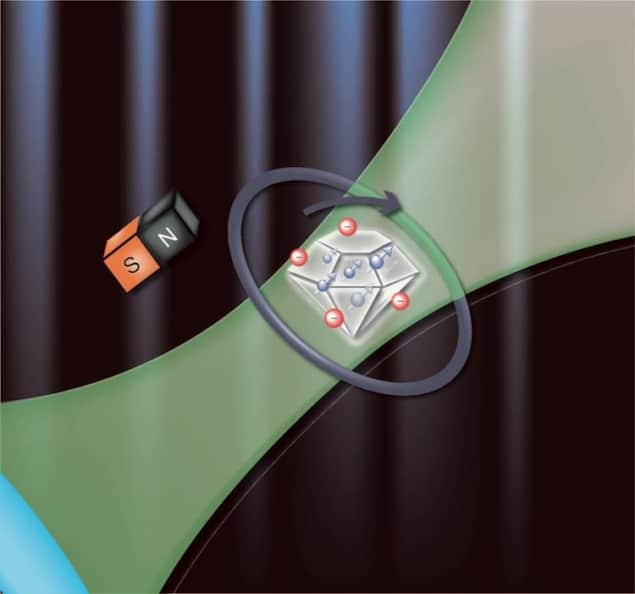
The force from the spin of defects known as nitrogen vacancy (NV) centres can be used to cool down a macroscopic diamond particle. This “spin cooling” method, which has been demonstrated for the first time by a team of researchers from the Ecole Normale Supérieure in France, is conceptually similar to the laser cooling of atoms, in which the radiation pressure exerted by laser photons dramatically reduces the speed of trapped atoms and thus their temperature. The new technique might therefore be as promising for future applications as laser cooling was, says Gabriel Hétet, who led the study.
In their experiments, the researchers used a handful of nitrogen atoms to cool a trapped diamond crystal made up of billions of carbon atoms. The nitrogen atoms were present in the form of impurities that arise when adjacent carbon atoms in the diamond lattice are replaced by a nitrogen (N) atom and an empty lattice site, or vacancy (V). The resulting NV centre is an atom-like system with well-defined electronic spin properties, and it can be optically polarized so that one spin direction is more prevalent than the other. Another important property is that an NV centre’s spin is shielded from its surroundings for relatively long periods – meaning that it has good coherence.
Spin-mechanical coupling effect
Hétet and colleagues say they succeeded in using the spin of many NV centres to affect the orientation of their trapped diamond crystal. Since the torque applied by the NV centre’s electronic spin is delayed with respect to the motion of the diamond particle – something that is possible because of the long coherence lifetime of the NV centres – this torque can cool down the motion of the particle, and thus reduce its temperature. This spin-mechanical cooling effect is similar to the way in which electrons orbiting around atoms are used to cool the motion of the atoms themselves in some laser-cooling protocols.
Strong coupling between individual quantum systems (such as spins) and mechanical oscillators is currently a hot topic in quantum physics research, Hétet says. However, while the mechanical motion of these oscillators can be “read out” using spin systems and vice versa, no one had ever succeeded in cooling a macroscopic object using NV centres until now.

The diamond quantum revolution
High-precision torque sensing and other applications
The diamond – which is levitated using electric field gradients in a vacuum – can operate as a “compass”, Hétet explains, and could thus be used in high-precision torque sensing applications. He adds that the group’s method could also make it possible to read out the spin of the NV centres in a non-destructive way under ambient conditions, as well as engineer the entanglement (or correlation) between several individual spins and in techniques like matter-wave interferometry.
The researchers, who report their work in Nature, say that they will now push the oscillation frequency of the diamond particle beyond the decoherence rate of the NV spins. “This strategy will enable us to reach the so-called resolved sideband regime at which the above-mentioned applications will be possible,” Hétet tells Physics World.



